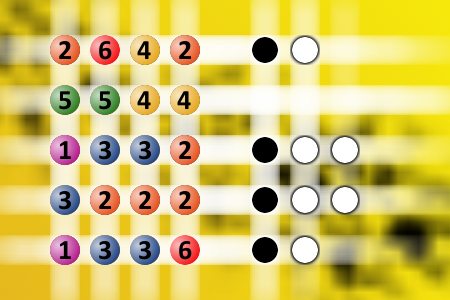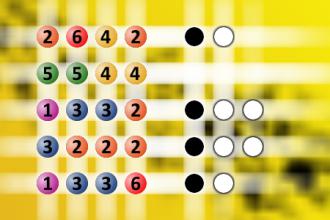Find the right combination
The computer chose a secret code (sequence of 4 digits from 1 to 6). Your goal is to find that code. Black circles indicate the number of hits on the right spot. White circles indicate the number of hits on the wrong spot.Correct answers: 20
The first user who solved this task is Nasrin 24 T.
#brainteasers #mastermind

MONDAY: It's fun to cook for...
MONDAY: It's fun to cook for Tom. Today I made angel food cake. The recipe said beat 12 eggs separately. The neighbors were nice enough to loan me some extra bowls.
TUESDAY: Tom wanted fruit salad for supper. The recipe said serve without dressing. So I didn't dress. What a surprise when Tom brought a friend home for supper.
WEDNESDAY: A good day for rice. The recipe said wash thoroughly before steaming the rice. It seemed kind of silly but I took a bath anyway. I can't say it improved the rice any.
THURSDAY: Today Tom asked for salad again. I tried a new recipe. It said prepare ingredients, lay on a bed of lettuce one hour before serving. Tom asked me why I was rolling around in the garden.
FRIDAY: I found an easy recipe for cookies. It said put the ingredients in a bowl and beat it. There must have been something wrong with this recipe. When I got back, everything was the same as when I left.
SATURDAY: Tom did the shopping today and brought home a chicken. He asked me to dress it for Sunday (oh boy).For some reason Tom keeps counting to ten.
SUNDAY: Tom's folks came to dinner. I wanted to serve roast but all I had was hamburger. Suddenly I had a flash of genius. I put the hamburger in the oven and set the controls for roast. It still came out hamburger, much to my disappointment.
GOOD NIGHT DEAR DIARY. This has been a very exciting week. I am eager for tomorrow to come so I can try out a new recipe on Tom. If I can talk Tom into buying a bigger oven, I would like to surprise him with chocolate moose.
TUESDAY: Tom wanted fruit salad for supper. The recipe said serve without dressing. So I didn't dress. What a surprise when Tom brought a friend home for supper.
WEDNESDAY: A good day for rice. The recipe said wash thoroughly before steaming the rice. It seemed kind of silly but I took a bath anyway. I can't say it improved the rice any.
THURSDAY: Today Tom asked for salad again. I tried a new recipe. It said prepare ingredients, lay on a bed of lettuce one hour before serving. Tom asked me why I was rolling around in the garden.
FRIDAY: I found an easy recipe for cookies. It said put the ingredients in a bowl and beat it. There must have been something wrong with this recipe. When I got back, everything was the same as when I left.
SATURDAY: Tom did the shopping today and brought home a chicken. He asked me to dress it for Sunday (oh boy).For some reason Tom keeps counting to ten.
SUNDAY: Tom's folks came to dinner. I wanted to serve roast but all I had was hamburger. Suddenly I had a flash of genius. I put the hamburger in the oven and set the controls for roast. It still came out hamburger, much to my disappointment.
GOOD NIGHT DEAR DIARY. This has been a very exciting week. I am eager for tomorrow to come so I can try out a new recipe on Tom. If I can talk Tom into buying a bigger oven, I would like to surprise him with chocolate moose.

